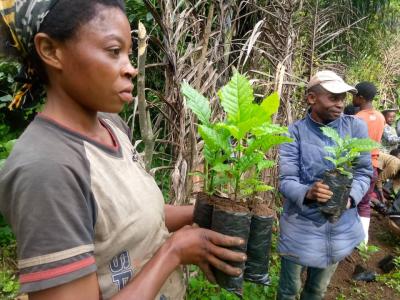Like most African countries, the Democratic Republic of Congo is in the process of implementing the United Nations Framework Agreement on Climate change. Within the framework of its Initial National Communication, it has undertaken studies on the country’s vulnerability and adaptation strategy in priority areas such as water resources, agriculture and coastline. The country’s objective in terms of water resources is mainly to ensure correct water supply to the populations of major urban centres such as Kinshasa, Lubumbashi and Kananga. The water catchment, production and distribution infrastructure will therefore have to be rehabilitated and/or developed. In the agricultural area, the major challenge is for DRC to ensure food security in the long term despite changing weather conditions. The Democratic Republic of Congo is a totally land-locked country with a few km-long coastline along the Atlantic Ocean; it is limited to the west by the Kabinda District of Angola and the Republic of Congo, to the north, by the Central African Republic and Sudan, to the east, by Uganda, Rwanda, Burundi and Tanzania, and to the south, by Zambia and Angola. It extends over a total area of about 2,350,000 square km. In Africa, only Sudan and Algeria have a larger territory than DRC. DRC’s territory stretches between Latitude 5°30' North and Latitude 13°50' South and one-third of the country area is located north of the Equator. DRC offers an exceptionally great diversity of biomes, ecosystems, habitats including notably dry rainforests or Muhulu, open woodland forests or Miombo, the full savannah range as well as cloud and gallery forests. A vast network of protected areas representing about 8% of the national territory preserve this variety of ecosystems.The country’s landscape is dominated by the world’s second largest area of tropical rainforest—which stores 8 per cent of global forest carbon—as well as mountainous terraces, plateaus, savannahs, grasslands and mountains. Although incredibly rich in natural resources such as timber, energy, minerals and gemstones, the DRC is presently ranked 168 out of 169 on the UNDP’s Human Development Index. DRC is one of the most populated countries in Africa with an estimated population of 52,100,000 inhabitants in 1999 growing at a rate of about 3%. Worsening socio-economic conditions, political instability and civil war have contributed to increased migration from the rural areas towards the cities. About 70 per cent of the economy is informal, and dominated by rural sectors; industrial development remains embryonic. Per capita GDP in 2008 was US$182. There is an enormous legacy of conflict in the country due to the Second Congo War (1998 to 2003). Insecurity persists in the east of the country and continues to cause the loss of human life and limit development efforts. Substantial environmental damage and degradation has been one of many results of the country’s past and present conflicts.
Projects Completed
Latest Updates
See allLatest Publications
See allThis country briefing on the process to formulate and implement National Adaptation Plans in the Democratic Republic of the Congo (DRC) considers…









